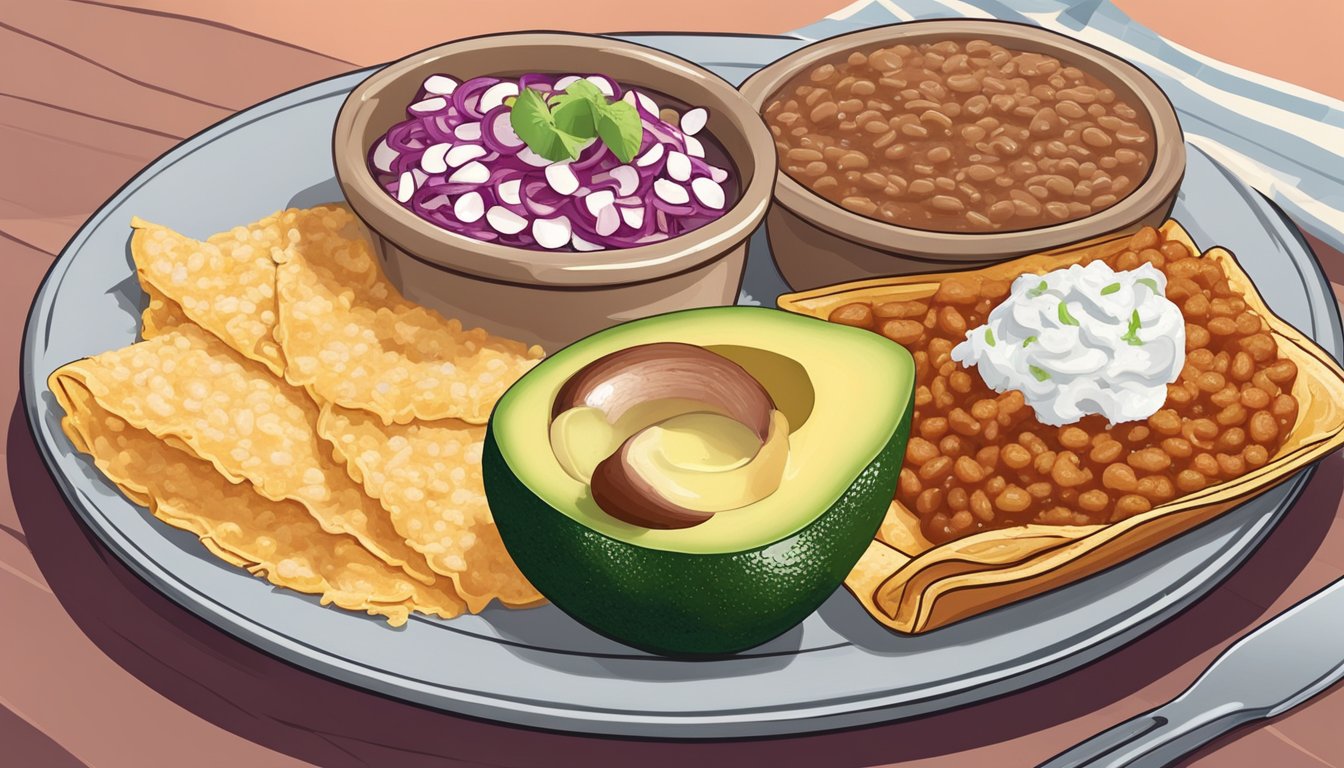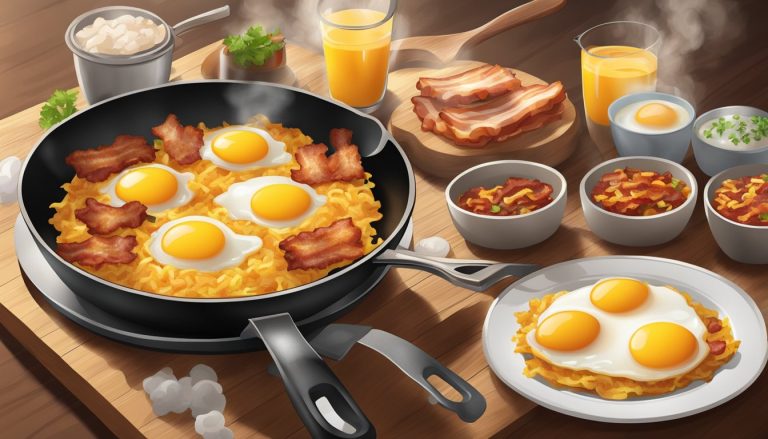Enfrijoladas are a beloved Mexican breakfast dish that combines simplicity with rich flavors. These corn tortillas drenched in a velvety black bean sauce offer a comforting start to any morning. The best breakfast enfrijoladas are made with freshly prepared tortillas, a smooth and savory bean sauce, and complementary toppings that add texture and taste.
This traditional dish showcases the versatility of humble ingredients like beans and corn tortillas. The preparation process involves blending black beans with aromatic spices and vegetables to create a creamy sauce. The tortillas are then lightly fried and bathed in this flavorful mixture. Toppings such as crumbled queso fresco, diced onions, and fresh cilantro add brightness and contrast to the dish.
Enfrijoladas can be customized with various fillings, including cheese, shredded chicken, or scrambled eggs. The combination of protein-rich beans and corn provides a nutritious and satisfying meal that has been a staple in Mexican households for generations. Whether enjoyed in a bustling Mexico City café or prepared at home, enfrijoladas offer a taste of authentic Mexican cuisine that is both comforting and delicious.
History and Origins
Enfrijoladas have deep roots in Mexican culinary tradition. This hearty breakfast dish originated in the central and southern regions of Mexico, with states like Veracruz and Oaxaca playing key roles in its development.
The name “enfrijoladas” comes from the Spanish word “frijol,” meaning bean. This reflects the dish’s primary ingredient and its importance in Mexican cuisine.
Enfrijoladas emerged as a practical way to use leftover tortillas and beans, two staple ingredients in Mexican households. The dish exemplifies the resourcefulness of Mexican cooks in creating flavorful meals from simple ingredients.
While the exact date of enfrijoladas’ creation is unknown, it has been a part of Mexican food culture for generations. The dish’s popularity grew as it spread from rural areas to cities across Mexico.
Enfrijoladas showcase regional variations throughout the country. In Oaxaca, they often feature black beans, while other areas might use pinto or bayo beans. These differences highlight the diverse culinary landscape of Mexico.
Today, enfrijoladas remain a beloved breakfast option in Mexican homes and restaurants. They continue to evolve, with modern cooks experimenting with new fillings and toppings while maintaining the dish’s traditional essence.
Nutritional Information

Enfrijoladas offer a nutrient-dense breakfast option, combining the benefits of beans with other wholesome ingredients. They provide a balanced mix of macronutrients and essential vitamins and minerals.
Health Benefits of Beans
Beans, the star ingredient in enfrijoladas, are packed with fiber. This nutrient aids digestion, promotes feelings of fullness, and helps regulate blood sugar levels. Beans are also rich in protein, supporting muscle health and repair.
Black beans and pinto beans, commonly used in enfrijoladas, contain antioxidants that may reduce inflammation and protect against chronic diseases. These legumes are excellent sources of folate, iron, and magnesium.
Beans contribute to heart health by potentially lowering cholesterol levels. Their high mineral content, including potassium and magnesium, supports bone health and helps maintain healthy blood pressure.
Macronutrient Breakdown
A typical serving of enfrijoladas provides a well-balanced distribution of macronutrients:
| Macronutrient | Amount per serving |
|---|---|
| Protein | 15-20g |
| Carbohydrates | 40-50g |
| Fat | 10-15g |
The protein content comes primarily from beans and cheese toppings. Carbohydrates are supplied by corn tortillas and beans, offering both quick and slow-release energy.
Fiber content is significant, ranging from 10-15g per serving. This aids in digestion and promotes satiety. The fat content varies based on preparation methods and toppings used.
Enfrijoladas can be customized to meet specific dietary needs. Using whole grain tortillas increases fiber content, while adjusting toppings can modify protein and fat levels.
Basic Ingredients
Crafting delicious breakfast enfrijoladas requires a careful selection of key ingredients. The quality and combination of these components significantly impact the final flavor and texture of this traditional Mexican dish.
Choosing Tortillas
Corn tortillas are the foundation of authentic enfrijoladas. Opt for fresh, high-quality corn tortillas for the best results. These tortillas should be pliable and have a distinct corn aroma. Store-bought tortillas work well, but homemade versions can elevate the dish. Flour tortillas are not typically used for enfrijoladas, as they lack the traditional flavor and texture.
White or yellow corn tortillas both work well. The choice often depends on regional preferences and availability. Yellow corn tortillas tend to have a slightly sweeter taste, while white corn tortillas offer a more neutral flavor profile.
Types of Beans
Black beans and pinto beans are the most common choices for enfrijoladas. Black beans provide a rich, earthy flavor and create a deep, appealing color. Pinto beans offer a creamier texture and milder taste.
For convenience, canned beans can be used. However, cooking dried beans from scratch allows for better control over flavor and texture. Soak dried beans overnight, then simmer with garlic, onion, and salt for enhanced taste.
The beans should be well-cooked and easily mashed to create a smooth sauce. A food processor or blender helps achieve the desired consistency.
Cheese Varieties
Queso fresco is the traditional cheese for enfrijoladas. This fresh, crumbly Mexican cheese adds a mild, tangy flavor and creamy texture. It’s typically crumbled over the top of the dish.
Other suitable options include:
- Cotija: A saltier, more aged cheese
- Oaxaca: A stringy, mozzarella-like cheese
- Monterey Jack: A mild, melting cheese
For a vegan version, nutritional yeast or plant-based cheese alternatives can be used.
Essential Spices and Herbs
The right blend of spices and herbs enhances the flavor profile of enfrijoladas. Key ingredients include:
- Cumin: Adds warmth and depth
- Mexican oregano: Provides an earthy, citrusy note
- Salt: Enhances overall flavors
- Garlic: Fresh or powdered, for aromatic flavor
- Onion: Adds sweetness and depth
Fresh cilantro is often used as a garnish, adding a bright, fresh flavor. Some recipes incorporate dried chili peppers or chipotle peppers for a smoky heat.
Adjust spice levels to personal preference. Start with small amounts and taste as you go. Remember, the goal is to complement, not overpower, the bean flavor.
Preparation Techniques
Mastering enfrijoladas requires attention to key steps: cooking beans properly, crafting a flavorful sauce, and assembling the dish with care. Each component contributes to the overall taste and texture of this beloved Mexican breakfast.
Cooking the Beans
Start with dried black beans for the best flavor. Soak them overnight to reduce cooking time. Drain and rinse the beans, then place in a large pot with fresh water. Add a few garlic cloves and a quartered onion for depth.
Bring to a boil, then reduce heat and simmer for 1-2 hours until tender. Avoid adding salt until beans are soft, as it can toughen the skins. Once cooked, reserve some cooking liquid for the sauce.
For a quicker option, use canned black beans. Rinse them well to remove excess sodium.
Prepping Enfrijoladas Sauce
Blend cooked beans with their liquid or vegetable stock until smooth. Heat olive oil in a pan and sauté minced garlic until fragrant. Add the bean puree and simmer, stirring frequently.
Season with salt, pepper, and optional spices like cumin or chipotle. Adjust consistency with reserved cooking liquid or stock. The sauce should coat the back of a spoon but remain pourable.
For extra depth, some recipes incorporate dried chilies or epazote. Taste and adjust seasoning as needed.
Filling and Wrapping Tortillas
Warm corn tortillas on a comal or in a dry skillet to make them pliable. Dip each tortilla in the warm bean sauce, coating both sides. Place on a plate and add your chosen filling.
Common fillings include queso fresco, shredded chicken, or scrambled eggs. Fold the tortilla in half or roll it up. Spoon additional sauce over the top.
Garnish with crumbled queso fresco, diced onions, and cilantro. Some versions include a drizzle of Mexican crema or a sprinkle of cotija cheese.
Serve immediately while the tortillas are still soft and the sauce is warm.
Cooking Methods
Enfrijoladas can be prepared using different cooking techniques, each imparting unique flavors and textures to the dish. The choice of method often depends on personal preference and available equipment.
Baking vs. Frying
Baking enfrijoladas offers a healthier alternative to frying. Preheat the oven to 375°F (190°C). Dip tortillas in the bean sauce and arrange them in a baking dish. Add fillings and roll or fold the tortillas. Cover with remaining sauce and cheese. Bake for 15-20 minutes until cheese melts and edges crisp.
Frying creates a crispy exterior. Heat vegetable oil in a fry pan over medium heat. Dip tortillas in bean sauce and fry for 30 seconds per side. Remove excess oil on paper towels. Fill, roll, and top with additional sauce and garnishes.
Stovetop Simmering
Stovetop simmering is a traditional method. Heat bean sauce in a large skillet. Dip tortillas in the sauce, allowing them to soften. Fill with desired ingredients and fold or roll. Simmer in the sauce for 2-3 minutes, turning once. This technique ensures the tortillas absorb the rich flavors of the bean sauce.
For added depth, sauté onions and garlic in the pan before adding the bean sauce. This creates a flavorful base for simmering the enfrijoladas.
Serving Suggestions

Enfrijoladas offer a versatile canvas for customization. Enhance your breakfast experience with carefully chosen proteins, flavorful garnishes, and complementary side dishes.
Protein Options
Shredded chicken provides a classic protein addition to enfrijoladas. Cook and shred boneless chicken breast or thighs, seasoning with cumin and chili powder for extra flavor. For a vegetarian option, scrambled or fried eggs make an excellent choice. The runny yolk mixes beautifully with the bean sauce. Chorizo, a spicy Mexican sausage, adds a bold, smoky flavor when crumbled and cooked before being added to the dish. For a lighter option, consider grilled shrimp or flaked white fish.
Garnishing for Flavor
Fresh toppings elevate enfrijoladas from good to great. Crumbled queso fresco or cotija cheese adds a salty, tangy element. Chopped onions provide a sharp crunch, while sliced avocado contributes creamy richness. A dollop of Mexican crema or sour cream balances the dish with cool tanginess. Chopped cilantro brings a burst of fresh, herbal flavor. A squeeze of lime juice brightens the overall taste. For heat lovers, sliced jalapeños or a drizzle of hot sauce can be added.
Pairing with Sides
Complement your enfrijoladas with traditional Mexican sides. Arroz rojo (red rice) offers a flavorful, slightly spicy accompaniment. Fresh fruit like mango or papaya provides a sweet contrast to the savory dish. For added vegetables, consider calabacitas (Mexican squash) sautéed with corn and peppers. A simple side salad with mixed greens, tomatoes, and a lime vinaigrette adds freshness. Warm corn tortillas on the side allow for scooping up any extra bean sauce. For a breakfast-style pairing, crispy hash browns or roasted potatoes work well.
Customizing Your Enfrijoladas

Enfrijoladas offer endless possibilities for personalization. Adapt the dish to suit various dietary preferences and experiment with diverse toppings and fillings to create your perfect breakfast.
Vegetarian Adaptations
Black bean sauce forms the base of vegetarian enfrijoladas. Replace meat fillings with roasted vegetables like bell peppers, zucchini, and mushrooms. Crumbled tofu or plant-based chorizo alternatives provide protein-rich options.
For a vegan version, use dairy-free cheese and cashew cream instead of traditional queso fresco and sour cream. Avocado slices add creaminess without animal products.
Consider using whole grain or corn tortillas for added nutrition and flavor. Enhance the bean sauce with smoky chipotle peppers or roasted garlic for depth.
Alternative Toppings and Fillings
Shredded chicken offers a lighter meat option compared to traditional chorizo. For a heartier variation, use slow-cooked pulled pork or beef barbacoa.
Experiment with different cheeses like cotija, Oaxaca, or manchego. Fresh toppings can include diced tomatoes, sliced radishes, or pickled red onions for a tangy crunch.
Try a fried egg on top for extra richness. Drizzle with Mexican crema or chipotle sauce for added flavor. Sprinkle with toasted pumpkin seeds or crispy fried onions for texture.
For a fusion twist, incorporate non-traditional ingredients like kimchi or Thai basil. These unexpected additions can create exciting flavor profiles.
Troubleshooting Common Issues

Creating perfect enfrijoladas requires attention to detail. Two key areas to focus on are maintaining tortilla texture and achieving balanced flavors.
Avoiding Soggy Tortillas
To prevent soggy tortillas, lightly fry them in oil before dipping in bean sauce. This creates a barrier that slows absorption. Alternatively, briefly dip tortillas in hot bean sauce rather than soaking them. Serve enfrijoladas immediately after preparation to maintain crispness.
For make-ahead options, keep tortillas and sauce separate until serving time. Warm tortillas just before assembling. Use a thicker bean sauce to reduce excess moisture. Place a thin layer of cheese or meat filling inside tortillas as an additional barrier against sogginess.
Balancing Flavors
Adjust seasoning in bean sauce for optimal taste. Add salt gradually, tasting as you go. Incorporate small amounts of cumin, oregano, or chili powder for depth. Balance richness with acidity using lime juice or a splash of vinegar.
For heat, include diced jalapeños or chipotle peppers in adobo sauce. Adjust quantity based on preference. Complement bean flavor with toppings like crumbled queso fresco, diced onions, or cilantro. Serve with a side of salsa for added complexity.
If sauce is too thick, thin with broth or water. For a richer taste, blend in a small amount of cream or butter. Taste and adjust seasonings after each addition to achieve the perfect balance.
Drinks to Complement Your Breakfast

A well-chosen beverage can elevate the enjoyment of breakfast enfrijoladas. Coffee is a classic choice that pairs excellently with this savory dish. A bold Mexican roast or a smooth espresso can provide a rich contrast to the flavors of the beans and tortillas.
For those seeking traditional Mexican drinks, horchata offers a refreshing option. This rice-based beverage, flavored with cinnamon, provides a cool and creamy counterpoint to the warmth of the enfrijoladas.
Fresh fruit juices also complement the meal nicely. Orange juice adds a bright, citrusy note, while a blend of tropical fruits like mango and pineapple can enhance the overall breakfast experience.
Yogurt-based drinks present a protein-rich alternative. A smoothie made with yogurt, banana, and a touch of honey can balance the savory elements of the enfrijoladas while offering nutritional benefits.
For a non-alcoholic take on a Mexican favorite, try a virgin michelada. This tangy, spiced tomato-based drink can cleanse the palate between bites of the flavorful enfrijoladas.
Here’s a quick reference for drink pairings:
| Drink Type | Suggestions |
|---|---|
| Coffee | Mexican roast, espresso |
| Mexican | Horchata, atole |
| Refreshing | Fruit juices, agua fresca |
| Yogurt-based | Smoothies, lassi |




